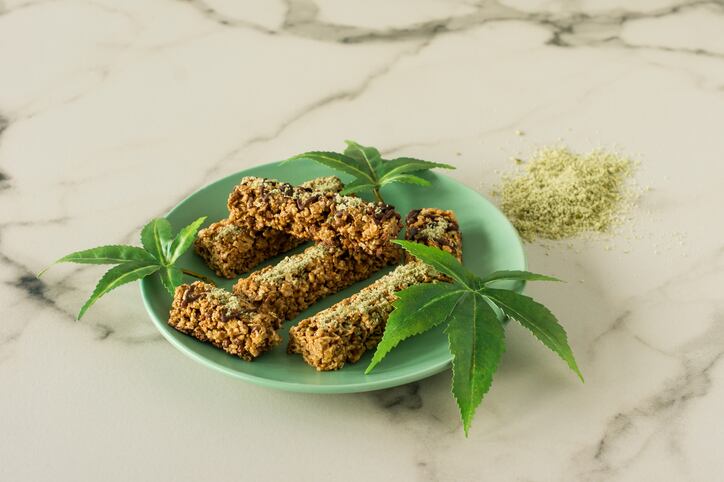The authors from Cosenza, Italy, studied the extraction of CBD from different parts of the Cannabis sativa L. plant, investigating various extracts in the formulation of optimised doughs for protein bar production.
Protein bar doughs were prepared with protein hemp flour and Greek yogurt, with the addition of CBD-enriched oil.
The authors found that the Greek yogurt addition reduced the consistency of the samples shifting the gelatinisation point to higher temperatures, and antioxidant properties were preserved after baking.
The authors conclude: “This research highlights the possibility of recovering CBD from hemp, inflorescences, and stalks for its use in the food industry, particularly for the production of high-protein bars.”
Significance
Cannabinoids, naturally found in Cannabis sativa L, are an emerging area of scientific research in line with the growing demand for alternative nutrients.
While drug-type cannabis has been extensively studied for pharmaceutical uses, researchers are increasingly exploring C. sativa L. (hemp), rich in fibre, for food and pharmaceutical purposes.
Hemp seeds are also used for their high-nutritional-value oil which is rich in polyunsaturated fatty acids, and hemp inflorescences contain various cannabinoids.
Cannabinoids, including cannabidiol (CBD), are of particular interest due to their antioxidant, anti-inflammatory, antibiotic, anxiolytic, and neuroprotective properties.
Various extraction methods are employed to obtain CBD-rich extracts, such as employing ethanol, which is preferred due to the easy separation method necessary to obtain CBD extracts, but can offer poor yield.
Soxhlet extraction is another technique used to obtain CBD, in which solvent reflux guarantees the maximum extraction of phytochemicals, however it can compromise the integrity of the cannabinoids extracted.
To authors propose that to obtain CBD-enriched extracts, a decarboxylation stage (a chemical reaction that removes a carboxyl group and releases carbon dioxide) could be inserted before the extraction process, to promote the conversion of cannabidiolic acid (CBDA) into CBD.
The properties of CBD oil from inflorescences and hemp seed oil have recently encouraged studies on food products based on hemp oil and protein, in which the positive effects of hemp protein are accompanied by the antioxidant and anti-inflammatory properties of CBD-rich hemp oil.
Therefore, the authors aimed to investigate different methods for extracting CBD and CBDA from hemp plants, analyse the extracts using high-pressure liquid chromatography (HPLC), and test their antioxidant power.
Study
Different extraction methods were used, and High-Pressure Liquid Chromatography HPLC analysis was used to analyse the extracts.
Antioxidant power was investigated using the 2,2-Diphenyl-1-picrylhydrazyl (DPPH) and 2,2′-azinobis-3-ethylbenzothiazoline-6-sulfonic acid (ABTS) assays.
Dynamic maceration (a conventional solid-lipid extraction procedure based on soaking a sample in organic solvents, followed by agitation, to obtain essential oils and bioactive compounds) was revealed to be the most efficient method to maximise CBD yield.
Results showed that the extract showed good antioxidant power with an IC50 value of 38.1 ± 1.1 µg/mL measured using the DPPH assay.
The CBD extract was added to the hemp oil to create dough, and the dough was studied by taking rheological and technological measurements.
The presence of CBD in the cooked dough was verified and quantified through HPLC analysis. In particular, a concentration of 0.36 ± 0.01 mg CBD/g snack was found.
The authors found that the protein bars could provide “an excellent means for the consumption of products enriched with antioxidants because their CBD anti-inflammatory activity is preserved after cooking.”
They do however note: “Since the mechanical and sensorial properties have not yet been studied in this work, the link between the structure and acceptability by the consumer deserves to be fully explored, possibly by adding other ingredients to the formulation, such as dried fruit/chocolate and so on."
Journal: Antioxidants
https://www.mdpi.com/2076-3921/12/11/1950
“Oil Extraction from Hemp Plant as a Potential Source of Cannabidiol for Healthy Protein Foods.”
Authors: Olga Mileti, Noemi Baldino, Francesca R. Lupi, Maria Marra, Domenico Lacopetta, Domenico Gabriele.


